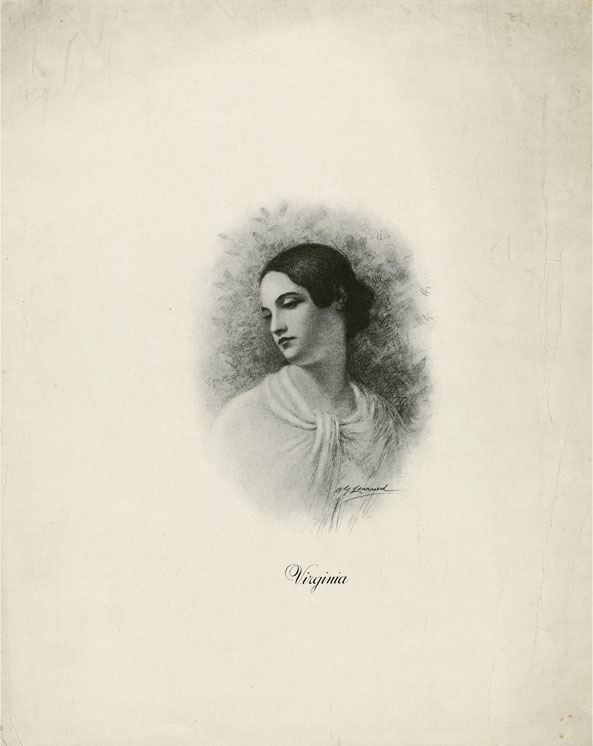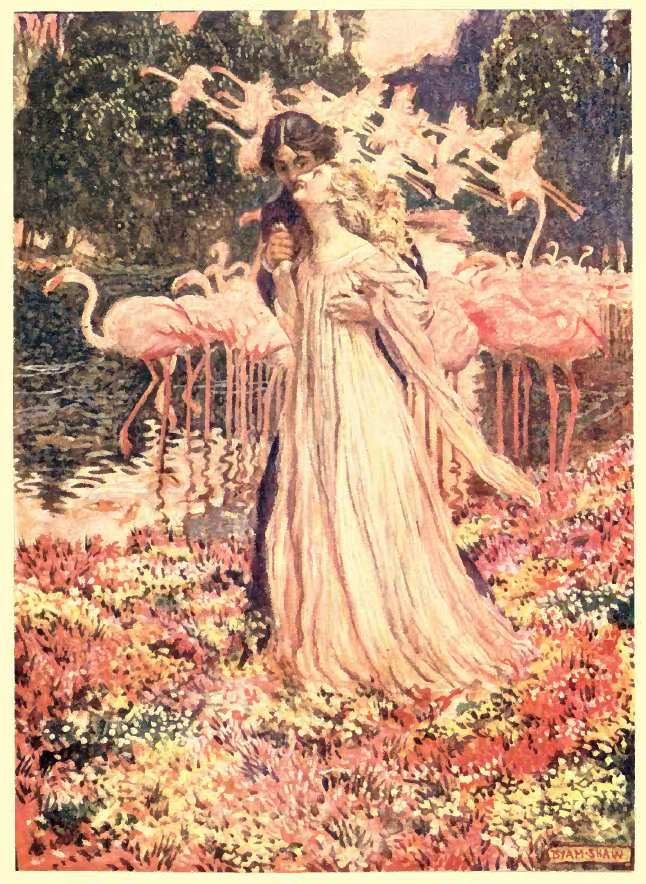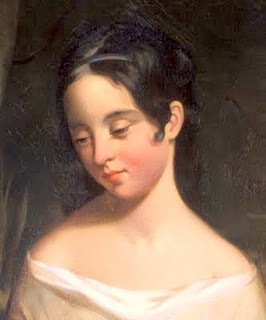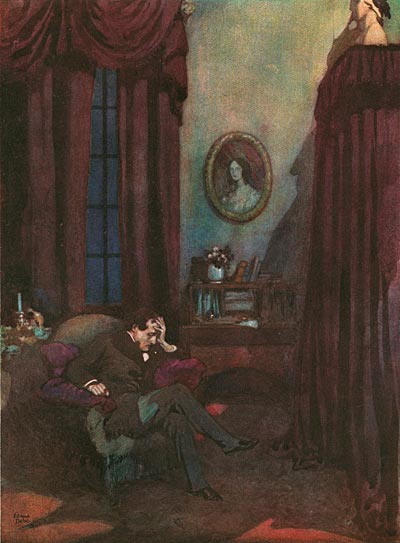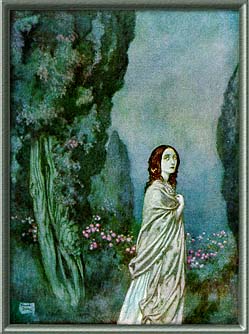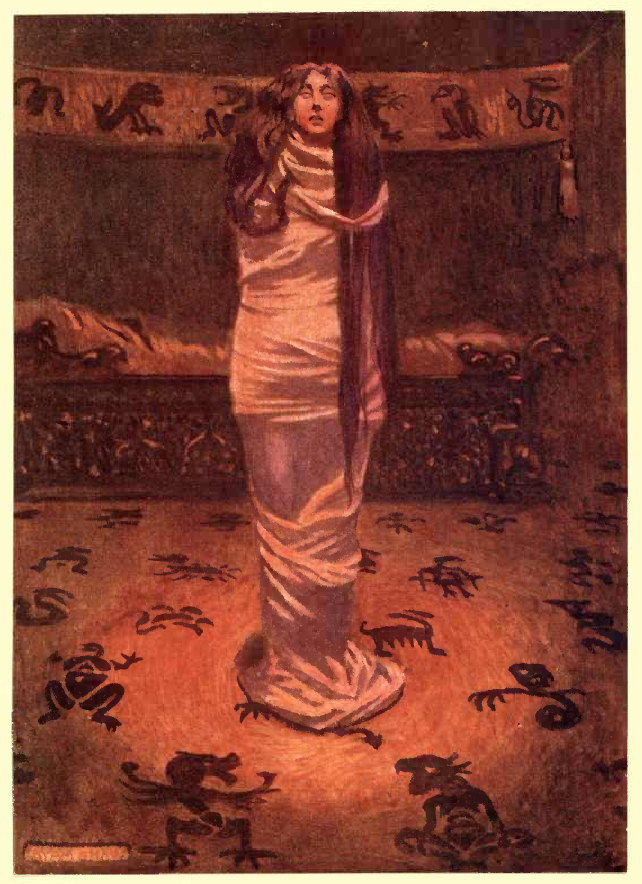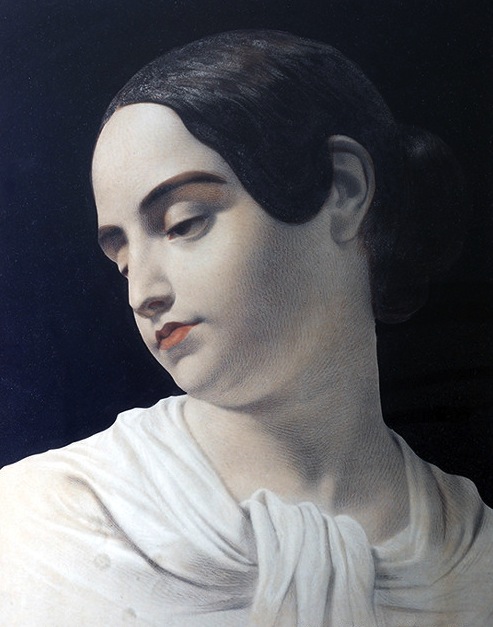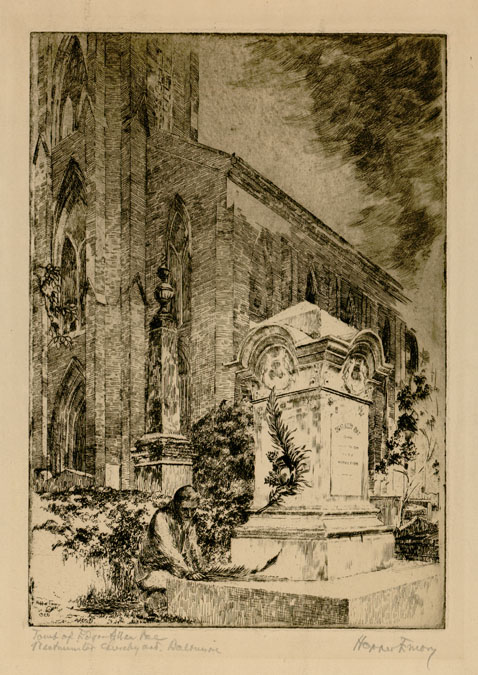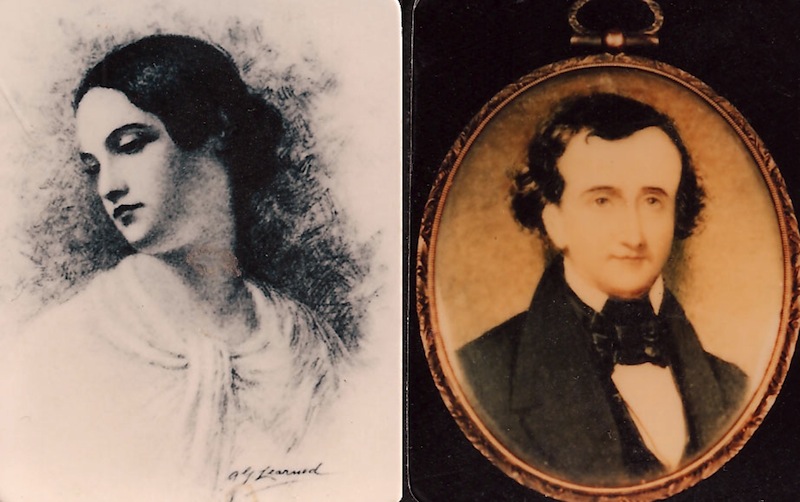Poe first met his paternal cousin – Virginia Clemm –  when she was 7 year old. Her father – William Clemm – died in 1826, leaving Virginia’s mother, Maria Poe, penniless. Maria moved her 3 children in with her mother – the widow of Edgar’s brother, David Poe. Maria’s mother – Elizabeth Cairnes Poe – was bedridden. She had a small pension with which she was able to rent a home in Baltimore. Edgar joined the household in 1833. He and Virginia, then 11, became close and she acted as a liaison between her cousin “Eddie” and  a neighbor girl named Mary Devereaux with whom he was smitten.
In Poe’s “Eleonora”, an unnamed narrator lives with his aunt and young cousin in “The Valley of the Many-Colored Grass,” a paradise of star-shaped flowers, birds with brilliant scarlet plumage and a “River of Silence”. The lush Valley was a hamlet where the 3 could live isolated but happy. In Elizabeth’s Baltimore home, Edgar and his little cousin whom he called “Sissy”, doted on each other, living as if in an eden apart from the world, walking “Hand in hand about this valley… before Love entered within our hearts.†Soon, companionship bloomed into courtship, and they were betrothed in 1835.
Edgar’s cousin, Neilson Poe, alarmed at the rumors of Edgar’s engagement to the 12 year old, offered to take Virginia in and have her educated rather than marry. Edgar, enraged at what he perceived as his cousin’s attempt to come between him and his beloved, called Neilson his “bitterest enemy” and wrote an overwrought letter to Maria, declaring himself to be “blinded with tears while writing,” having “no wish to live another hour” and pleading that she allow Virginia to make her own decision. Sissy and Eddy were married in a secret ceremony in Richmond on May 16, 1836, when Poe was twenty seven and Virginia was thirteen – although the marriage bond included an affidavit citing the bride’s age as “21”.
Virginia and Edger were by all accounts a loving and devoted couple. Poe’s one-time employer George Rex Graham wrote: “His love for his wife was a sort of rapturous worship of the spirit of beauty.” Indeed, Virginia was described as a girl of “matchless beauty and loveliness, her eye could match that of any houri, and her face defy the genius of a Canova to imitate”. Accounts have her as petite with large violet eyes that looked out from under heavy lids, sensuous lips forming a sort of pout; and a high, pale forehead framed by straight, raven black hair and skin so pale it was called “pure white”. Biographers remark on her child-like appearance even in the last years of her life and  her “air of refinement and good breeding.† Poe once wrote, rhapsodizing the brilliance and beauty of his wife, “I see no one among the living as beautiful as my little wife.”
Virginia nearly idolized her husband, sitting close to him while he wrote, keeping his pens and manuscripts in order. Edgar, in turn, doted on his bride. She loved gardening so he found a rooming house in Philadelphia with a small garden for her to tend. She loved music, so he bought her a harp and a piano, which he would accompany her with his flute. More girlish than womanly, Virginia preferred simple, girlish things to intellectual endeavors. Some scholars suggest that the couple never consummated their marriage and that Virginia died a virgin. It’s been speculated that Edgar, although susceptible to romantic infatuations, and having a deep appreciation for female beauty, may not really need women in a sexual sense, but only as a source of inspiration and care.
In January of 1842, the Poes held a small supper party in the foyer of their Spring Garden street residence in Philadelphia. Virginia wore a white linen dress, her long black hair framing her pale face as she entertained their by singing and playing her harp. She suddenly caught her breath and coughed violently. As the horrified guests looked on, blood began spouting from her mouth. Her white dress was crimson with blood. Her lungs hemorrhaged and she collapsed to the floor as her husband ran to her, in the terror of someone who knew what this meant.
Virginia was diagnosed with pulmonary tuberculosis – what polite society referred to as “consumption†of the lungs – which in early nineteenth-century America was a death sentence. Its symptoms were subtle at first: waxy, sallow complexion, hollow coughs, slight and intermittent fevers. Poe was well acquainted with consumption’s horrors, having watched it ravage his mother and brother, and had written implicitly about the illness’ last stages – the feverish skin that began as a comely glow, the swelling knees, the emaciated body, the gaunt and hallowed cheeks and glowing eyes, the unusual coloring, bilious attacks, and the relentless coughing…coughing that produced profuse hemorrhaging and bloody geysers that almost drowned the sufferer…Even though he remained in outward denial of Sissy’s illness – rarely speaking of it other than her having merely “ruptured blood vessel” – Edgar knew her fate only too well.
Consumption becomes torturous for the patient and their loved ones, as the sufferer would be abject, on the brink of death, only to bounce back from the disease and look healthy again. It was this cycle of hope and despair that Poe, like Egaeus in “Ligeia,†found most horrible in the disease. He writes in a letter dated January 4, 1848:
Her life was despaired of. I took leave of her forever & underwent all the agonies of her death. She recovered partially and I again hoped. At the end of a year…I went through precisely the same scene. Again in about a year afterward. Then again—again—again & even once again at varying intervals. Each time I felt all the agonies of her death—and at each accession of the disorder I loved her more dearly & clung to her life with more desperate pertinacity.  But I am constitutionally sensitive—nervous in a very unusual degree. I became insane, with long intervals of horrible sanity.
The ravages of “the white plague” accentuated Virginia’s grave and ghostly beauty. One Poe family friend noted that “the rose-tint upon her cheek was too bright,” a symptom of her illness. Another wrote, “Mrs. Poe looked very young; she had large black eyes, and a pearly whiteness of complexion, which was a perfect pallor. Her pale face, her brilliant eyes, and her raven hair gave her an unearthly look. One felt that she was almost a disrobed spirit, and when she coughed it was made certain that she was rapidly passing away”. Many commented on her “unearthly” suggesting it made her look not quite human: the paleness and wasting, the haunted appearance, the burning sunken, red eyes, the perspiring skin.
Virginia endured five years of the terrible disease, her suffering heightened by her husband’s depressive drinking binges, over his wife’s suffering, their poverty, and his own demons. She fretted Eleonora-like over his fate after her death, her health declined and she became infirm. Virginia admitted to a family friend, “I know I shall die soon; I know I can’t get well; but I want to be as happy as possible, and make Edgar happy.” She promised her husband that after her death she would be his guardian angel. She endured the latter part of her illness at the Poe Cottage in the Bronx, NY. Mrs. Mary Grove Nichols visited the Poes at this time, and recalled:
The autumn came, and Mrs. Poe sank rapidly in consumption, and I saw her in her bedchamber. Everything . . . was so neat, so purely clean, so scant and poverty-stricken . . . There was no clothing on the bed, which was only straw, but a snow white spread and sheets. The weather was cold, and the sick lady had the dreadful chills that accompany there [[the]] hectic fever of consumption. She lay on the straw bed, wrapped in her husband’s great-coat, with a large tortoise-shell cat on her bosom. The wonderful cat seemed conscious of her great usefulness. The coat and the cat were the sufferer’s only means of warmth, except as her husband held her hands, and her mother her feet.
It was shortly after the couple moved to New York that Poe published “The Oblong Box” (1844) to focus on the fearful reality that he was facing. The story shows a man mourning his young wife while transporting her corpse by boat. As the ship sinks, the husband would rather die than be separated from his wife’s corpse and ties himself to it with a rope as the ship descends into the sea.
On her deathbed, Virginia reenacted Eleonora’s forgiveness by asking lady friends to care for her husband, such as Mary Starr, who Poe had courted when Virginia was a child: “I had my hand in hers, and she took it and placed it in Mr. Poe’s, saying, ‘Mary, be a friend to Eddie, and don’t forsake him; he always loved you—didn’t you, Eddie?†While dying, Virginia asked her mother: “Darling… will you console and take care of my poor Eddy—you will never never leave him?” (her mother stayed with Poe until his own death in 1849).
Virginia died on January 30, 1847, cementing her legacy as the quintessential Poe Girl. like Eleonora, exquisite, sick, “made perfect in loveliness only to die”, in memorial statuary; cold and white, melancholy, and eternally young, beautiful.
Poe held an aesthetic belief  that  “… the death…of a beautiful woman is, unquestionably, the most poetical topic in the world”. Particularly when the death is from consumption, which does not deform, but rather increases beauty, skin paling to translucence , cheeks and lips reddening from fever. It is through this insidious transformation that temporal loveliness approaches the perfection of eternal beauty. Even the corpse incarnates the ideality.
The archetypal “Poe Girl” is abstruse, an enigma. She is not simply a memory, an absent presence – she is not Annabel Lee – but something more sinister….a child-woman who lives and breathes and permeates her lover’s soul. She is not an invalid waif cut down in the bloom of youth, but a specter that haunts her lover out of envy, revenge or anger or to forgive, guard or provide comfort to him. She is flawed: envious, powerful, passionate, the possessor of esoteric and arcane knowledge. While she will meet the same fate as Lenore, she does not die quietly and averts idealization and objectification by refusing to stay dead. Her unexpected capacity for life beyond the grave indicates an initiative that Poe’s more delicate flowers of verse do not possess.
In “Ligeiaâ€, the body of Rowena revivifies before collapsing back into death, each cycle falling farther into decay, from hot, flushed cheeks to lipless, clammy corpse. Poe’s poetic ladies are already entombed, so he never has to witness their (non-consumptive) deaths. The horrific wasting of Madeline Usher and Berenice, their emaciated bodies, “hollow temples”, and  “thin and shrunken lips†revolt the narrator. When he last sees Berenice, she is drastically emaciated, her hair changed from black to an incongruous, “vivid yellowâ€, her delicate pallor a death mask. She moves from the realm of the beautiful to that of the bizarre and repellent. Her eyes are lifeless, lustreless, seemingly pupil-less, with a glassy stare. Her lips are think and shrunken and when she smiles a smile of “peculiar meaning†it so horrifies the narrator that he apparently passes out. When his heroines fall ill while maintaing their beauty (“Morella, †“Ligeia, †“Eleonoraâ€), however, the narrator is at their deathbeds until their final breath.
A few hours after Virginia’s death, Poe realized that he had no image of his wife, and commissioned a watercolor using her corpse as the model.
A friend recalled that Poe “did not seem to care, after she was gone, whether he lived an hour, a day, a week or a year; she was his all.” A year after her death, he wrote to a friend that he had experienced the greatest evil a man can suffer when, he said, “a wife, whom I loved as no man ever loved before”, had fallen ill. Â Poe referred to his emotional response to his wife’s sickness as his own illness, and that he found the cure to it:
“in the death of my wife. This I can & do endure as becomes a man—it was the horrible never-ending oscillation between hope & despair which I could not longer have endured without the total loss of reason”.
Poe was often found in the dead of night, at his wife’s tomb, half frozen in the snow. In October 3, 1849, Poe was found delirious on the streets of Baltimore, haggard, filthy, with “lusterless and vacant” eyes, babbling about his “wife”. He was admitted to the hospital delirious and suffering from tremors and hallucinations before slipping into a coma. He emerged from the coma calm and lucid, then lapsed into delirium again. He died on October 7, 1849. According to the Baltimore Health Commissioner, the cause of death was “congestion of the brain.” Speculation as to the cause of death includes drug or alcohol overdose, suicide, murder, cholera, rabies, syphilis, influenza and that he was a victim of “cooping” (shanghai-ing men, drugging them, keeping them prisoner in cellars where they were threatened and maltreated and used as election pawns), or perhaps it was sheer Gothic exhaustion.
Poe’s final words were “Lord, help my poor soul”.
“The loveliness of Eleonora was that of the Seraphim; but she was a maiden artless and innocent as the brief life she had led among the flowers. She had seen that the finger of Death was upon her bosom—that, like the ephemeron, she had been made perfect in loveliness only to die”.

